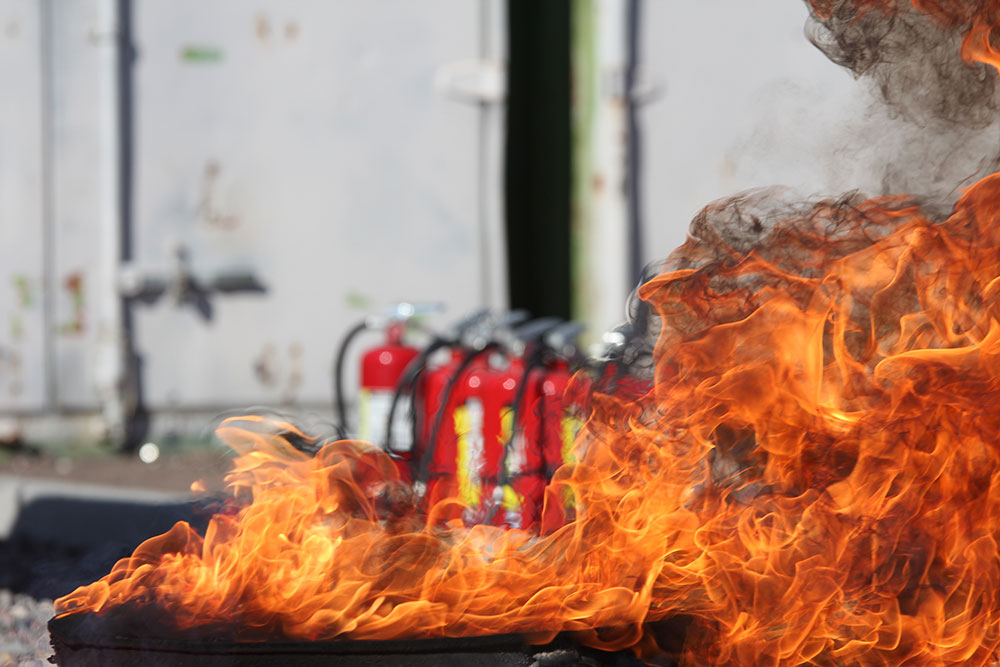Fire suppression training is crucial in managing fire emergencies before they become major catastrophic incidents. Office fires can cause significant damage to premises and equipment, not to mention the great risk they pose to life. Virtual reality training has revolutionised safety education, allowing for practical safety procedures and techniques to be shared and retained, and for trainees to practice their skills in realistic simulated environments. We take a closer look at how VR safety training has been applied to the area of fire safety and suppression, and how it helps to make workplaces safer.
Fire suppression training typically involves instructing trainees on how to identify and handle fire safety equipment, such as fire blankets or extinguishers. As it requires skills to be applied in real-time, fires need to be started, equipment needs to be purchased, and local authorities need to be notified of the training being conducted in case adverse consequences result. As with all fires, there is the potential for a training fire to get out of hand, and for trainees to suffer smoke and extinguisher dust inhalation. Virtual reality training removes these adverse risks of real-life training by placing the entire educational experience within a simulated environment, thus improving safety outcomes and making educational programs and training much more cost-effective.
Once they put on a VR headset, trainees will find themselves within a realistic simulated environment, such as an office kitchen. Kitchen spaces are a common source of fires, as they contain gas, electricity and fire elements within a small space, and simulated training within an office-style kitchen also prepares trainees to apply what they learn at home as well. Trainees will be exposed to an emergency fire situation, and need to identify proper safety equipment and use it to safely and effectively put out the fire.
With virtual reality training, trainees build muscle memory to be able to effectively handle an emergency with confidence and calm and to know which decisions and actions will lead to the most effective and safe outcomes. VR education proves to be more memorable, interactive and engaging than typical slideshows or lectures, with trainees more likely to retain information and internalise skills and techniques even before an emergency occurs. What’s more, simulating fire with VR prevents the need for real fires to be started, so there’s no risk of training fires getting out of control and causing damage.
More and more businesses are recognising the value of virtual reality in their fire suppression training modules. If your business or organisation is looking to create more effective, engaging and memorable safety training options for your employees or personnel, you need a reliable VR/AR creative studio company with a passion for innovation. 3D Walkabout is on hand to deliver quality, high-tech simulated training exercises to help your team learn and apply reliable safety techniques. When you choose VR for your fire suppression training, you’ll see improved information retention for your employees, reduced costs and time expenses, and better outcomes should a fire emergency eventuate at work.
Summary: How can virtual reality used in fire suppression training?
VR transforms fire suppression training by providing practical safety procedures and techniques through realistic simulated environments, enhancing workplace safety.
VR mitigates risks tied to live fire training, immersing trainees in simulated environments for safer and more cost-effective learning.
In the realm of fire suppression training, VR is a game-changer, delivering practical safety procedures and techniques through realistic simulated environments to elevate workplace safety.
Trainees experience realistic scenarios, like office kitchens, where they practice identifying safety equipment and effectively extinguishing fires, building muscle memory for confident emergency responses.
The adoption of VR for fire suppression training translates into enhanced information retention, reduced costs, and improved emergency outcomes for businesses, contributing to safer and more prepared workplaces.
FAQs
Is VR training cost effective?
When it comes to training and education, virtual reality (VR) can be a cost-effective alternative to traditional classroom lectures. VR lets students experience a real-life scenario in a safe environment that’s not only more engaging but also more cost-efficient.
Is VR training good?
Virtual reality (VR) training is a great way to train employees. It can be used for training employees on how to use a specific piece of equipment or software, as well as teaching them how to perform their jobs in the real world. It’s also useful for educating employees on how to handle a new situation or scenario.
How virtual reality is used in training?
Virtual reality is used in training to simulate real-world situations. It can be used to train a variety of skills, from operating heavy machinery to flying an aeroplane. This is accomplished by using a headset that has built-in headphones, which allow the user to hear what’s going on around them. The headset also blocks out all other sounds.
How do you start virtual reality training?
The first step in virtual reality training is to decide what kind of experience you want to provide your employees with. Do you want them to have an immersive experience with 3D visuals? Do you want them to feel like they’re there? Or do you just want them to learn how different tools work?
What is virtual reality training?
Virtual reality (VR) training is a way to train employees using computer-generated environments that mimic real-world situations. These environments can be created with video game engines or 3D modelling software, and they can be used to simulate any number of scenarios.


